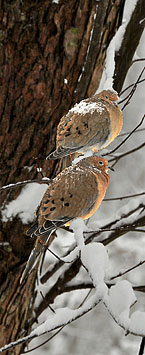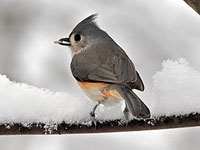More on Birds...
How do birds survive the winter?
 Birds might seem small and fragile, but they're fully adapted to stay alive through even the harshest conditions. When the weather turns cold, birds put on their down jackets, tuck in their feet and legs, and fluff up their feathers, creating an insulating layer of air. Birds might seem small and fragile, but they're fully adapted to stay alive through even the harshest conditions. When the weather turns cold, birds put on their down jackets, tuck in their feet and legs, and fluff up their feathers, creating an insulating layer of air.
They huddle together, sheltered in tree cavities or dense shrubs. Shivering produces more body heat and, at night, birds can actually lower their body temperature to save energy.
But even with these remarkable adaptations, winter weather can be a death sentence if birds cannot find enough food to keep up their energy. This is where we come in. With most food sources buried under the snow, backyard bird feeders can make the difference between life and death for many birds.
High-calorie seed mixes supplemented with a little food from your kitchen will help save the day and also provide many enjoyable hours of bird watching from the comfort of your home. Stock hanging feeders with black sunflower seeds, sunflower hearts, high-fat nuts and dried fruit. Blackbirds and thrushes appreciate apples and pears, suet blocks mixed with nuts or dried insects are life-savers for woodpeckers and many other birds.
Make sure your feeders are located in places where birds are safe from wandering cats… well fed cats are well known predators of birds. Feeders should be high off the ground and far enough away from anything a cat could use to jump to the feeder.
Water is important during every season. Birds need water every day, even when there's snow on the ground - melting snow inside little bird bodies takes more energy. Providing a place for a drink of clean water is so important, it may attract more birds than feeders.
Make sure you clean both water and feeders regularly to avoid contamination from droppings, especially when winter weather conditions make other food sources difficult to find and there are many, many birds at your backyard feeders. Then sit back and enjoy the show from inside your warm, snug home!
Great Backyard Bird Count 2010
 The four-day Great Backyard Bird Count begins on February 12! This nationwide citizen science project is just what it sounds like… volunteers record the birds seen in backyards, or wherever you happen to be. There’s no time limit, you can count birds all day or for an hour. The four-day Great Backyard Bird Count begins on February 12! This nationwide citizen science project is just what it sounds like… volunteers record the birds seen in backyards, or wherever you happen to be. There’s no time limit, you can count birds all day or for an hour.
At the end of the day, volunteers tally the highest number of each species seen together at one time and send the information to the Cornell Lab of Ornithology and the Audubon Society. While you're counting, you can also share the news about your observations on our Facebook page here.
Bird populations are dynamic and in flux. Tracking changes is a huge job, scientists need help from volunteers to document distribution and movements. Last year volunteers submitted 93,629 checklists, reporting 619 species and 11,550,200 individuals.
The results of this survey give scientists a snapshot of bird populations before spring migration begins. It’s useful for evaluating migration patterns, bird diversity in urban and suburban areas, impacts from the recent huge snowstorms and more.
According to the 2009 State of the Birds report, nearly a third of the 800 species of birds found in the U.S. are endangered, threatened or in decline. The Backyard Bird Count is a great opportunity to help scientists and us learn more about what’s happening regionally, close to home, and nationwide. |